
Aerospace and defense company Huntington Ingalls (NYSE: HII) fell short of the market’s revenue expectations in Q3 CY2024, with sales falling 2.4% year on year to $2.75 billion. Its GAAP profit of $2.56 per share was also 34.2% below analysts’ consensus estimates.
Is now the time to buy Huntington Ingalls? Find out by accessing our full research report, it’s free.
Huntington Ingalls (HII) Q3 CY2024 Highlights:
- Revenue: $2.75 billion vs analyst estimates of $2.86 billion (4% miss)
- EPS: $2.56 vs analyst expectations of $3.89 (34.2% miss)
- Gross Margin (GAAP): 11.7%, down from 14.8% in the same quarter last year
- Operating Margin: 3%, down from 6.1% in the same quarter last year
- Free Cash Flow Margin: 4.9%, down from 10.4% in the same quarter last year
- Backlog: $49.4 billion at quarter end, in line with the same quarter last year
- Market Capitalization: $9.82 billion
"Two issues have impacted our results and guidance for the year... our assumptions of performance improvement and risk reduction have not been achieved, due to late critical material deliveries from the supply chain and reduced experience levels within our teams, both in production touch labor and supervision," said Chris Kastner, HII’s president and CEO.
Company Overview
Building Nimitz-class aircraft carriers used in active service, Huntington Ingalls (NYSE: HII) develops marine vessels and their mission systems and maintenance services.
Defense Contractors
Defense contractors typically require technical expertise and government clearance. Companies in this sector can also enjoy long-term contracts with government bodies, leading to more predictable revenues. Combined, these factors create high barriers to entry and can lead to limited competition. Lately, geopolitical tensions–whether it be Russia’s invasion of Ukraine or China’s aggression towards Taiwan–highlight the need for defense spending. On the other hand, demand for these products can ebb and flow with defense budgets and even who is president, as different administrations can have vastly different ideas of how to allocate federal funds.
Sales Growth
A company’s long-term performance can indicate its business quality. Any business can put up a good quarter or two, but many enduring ones grow for years. Unfortunately, Huntington Ingalls’s 6.2% annualized revenue growth over the last five years was mediocre. This shows it couldn’t expand in any major way, a tough starting point for our analysis.
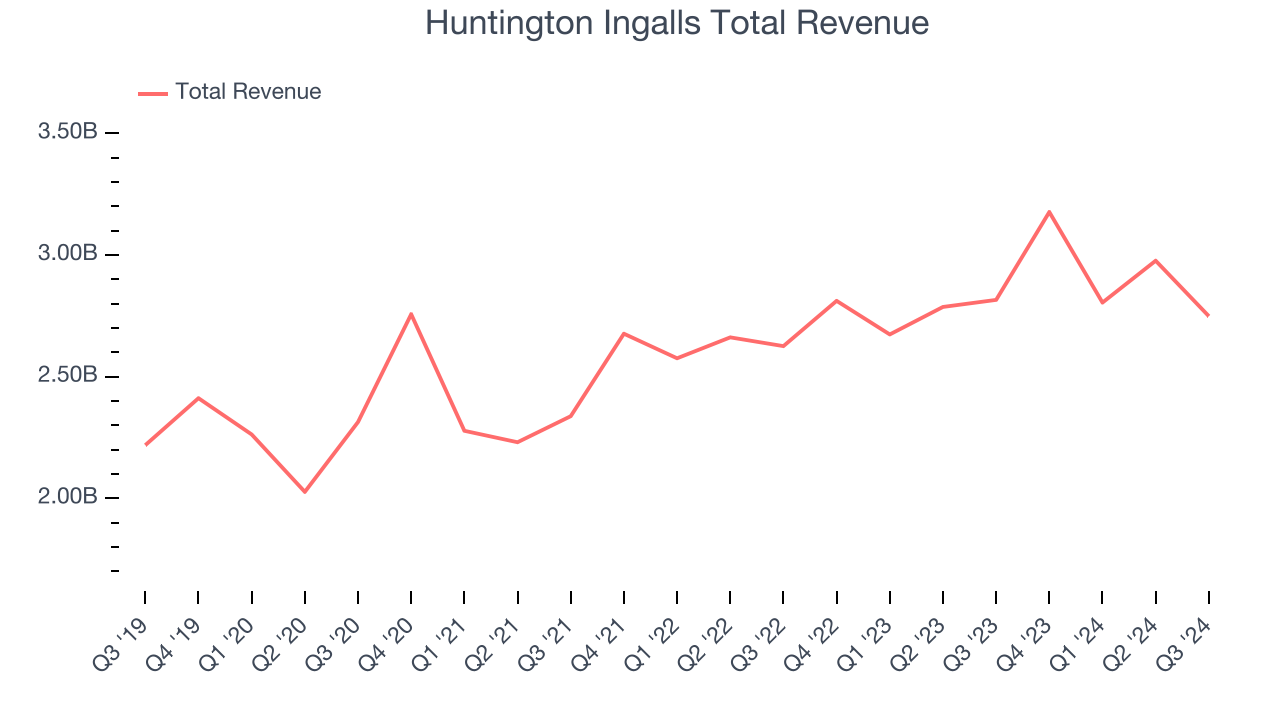
Long-term growth is the most important, but within industrials, a half-decade historical view may miss new industry trends or demand cycles. Huntington Ingalls’s annualized revenue growth of 5.4% over the last two years aligns with its five-year trend, suggesting its demand was consistently weak. 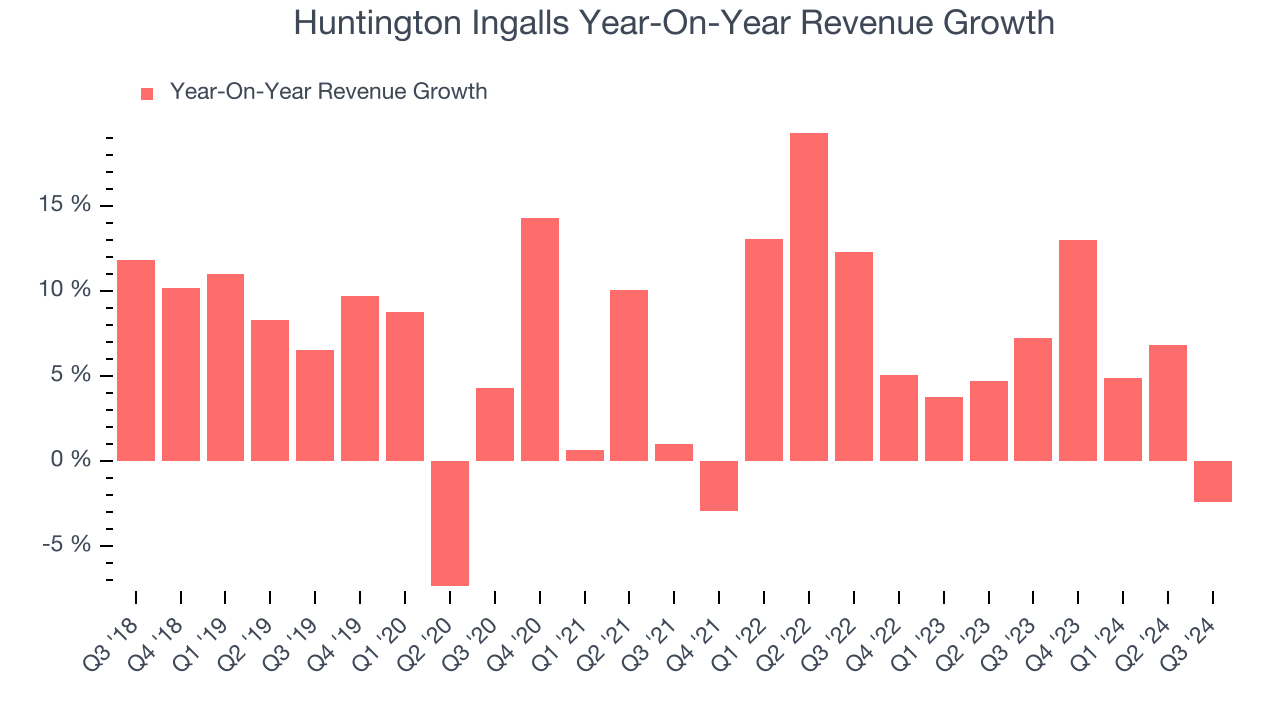
We can dig further into the company’s revenue dynamics by analyzing its backlog, or the value of its outstanding orders that have not yet been executed or delivered. Huntington Ingalls’s backlog reached $49.4 billion in the latest quarter and averaged 1.1% year-on-year growth over the last two years. Because this number is lower than its revenue growth, we can see the company hasn’t secured enough new orders to maintain its growth rate in the future. 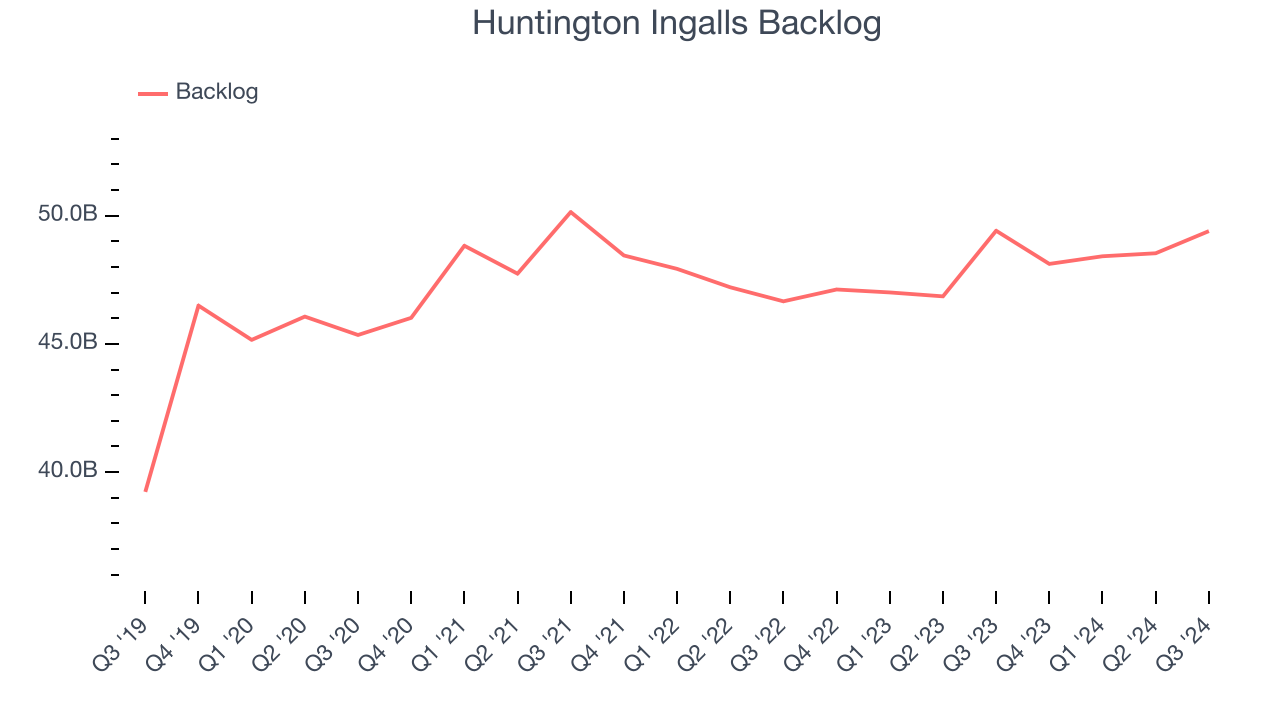
This quarter, Huntington Ingalls missed Wall Street’s estimates and reported a rather uninspiring 2.4% year-on-year revenue decline, generating $2.75 billion of revenue.
Looking ahead, sell-side analysts expect revenue to grow 2.5% over the next 12 months, a slight deceleration versus the last two years. This projection doesn't excite us and illustrates the market thinks its products and services will see some demand headwinds.
Today’s young investors won’t have read the timeless lessons in Gorilla Game: Picking Winners In High Technology because it was written more than 20 years ago when Microsoft and Apple were first establishing their supremacy. But if we apply the same principles, then enterprise software stocks leveraging their own generative AI capabilities may well be the Gorillas of the future. So, in that spirit, we are excited to present our Special Free Report on a profitable, fast-growing enterprise software stock that is already riding the automation wave and looking to catch the generative AI next.
Operating Margin
Operating margin is one of the best measures of profitability because it tells us how much money a company takes home after procuring and manufacturing its products, marketing and selling them, and, most importantly, keeping them relevant through research and development.
Huntington Ingalls was profitable over the last five years but held back by its large cost base. Its average operating margin of 6.3% was weak for an industrials business.
Analyzing the trend in its profitability, Huntington Ingalls’s annual operating margin decreased by 1.2 percentage points over the last five years. The company’s performance was poor no matter how you look at it. It shows operating expenses were rising and it couldn’t pass those costs onto its customers.
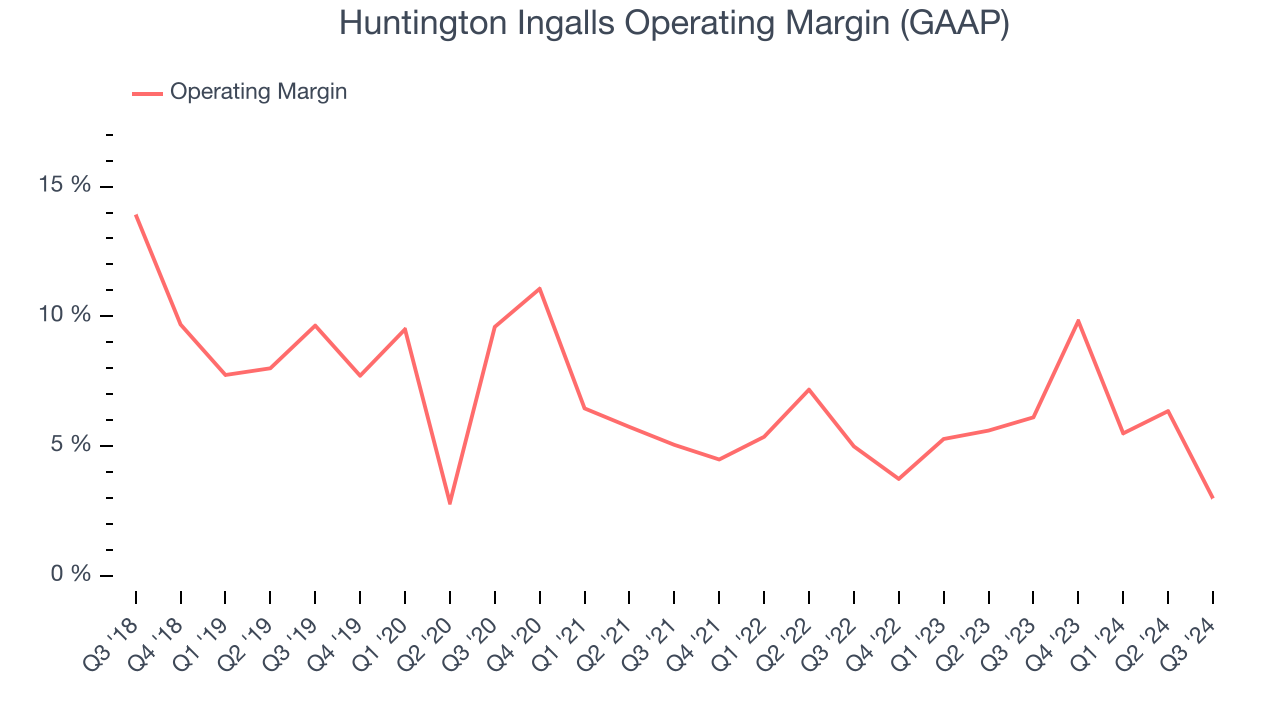
In Q3, Huntington Ingalls generated an operating profit margin of 3%, down 3.1 percentage points year on year. This contraction shows it was recently less efficient because its expenses increased relative to its revenue.
Earnings Per Share
Analyzing revenue trends tells us about a company’s historical growth, but the long-term change in its earnings per share (EPS) points to the profitability of that growth – for example, a company could inflate its sales through excessive spending on advertising and promotions.
Huntington Ingalls’s EPS grew at a weak 3.9% compounded annual growth rate over the last five years, lower than its 6.2% annualized revenue growth. This tells us the company became less profitable on a per-share basis as it expanded.
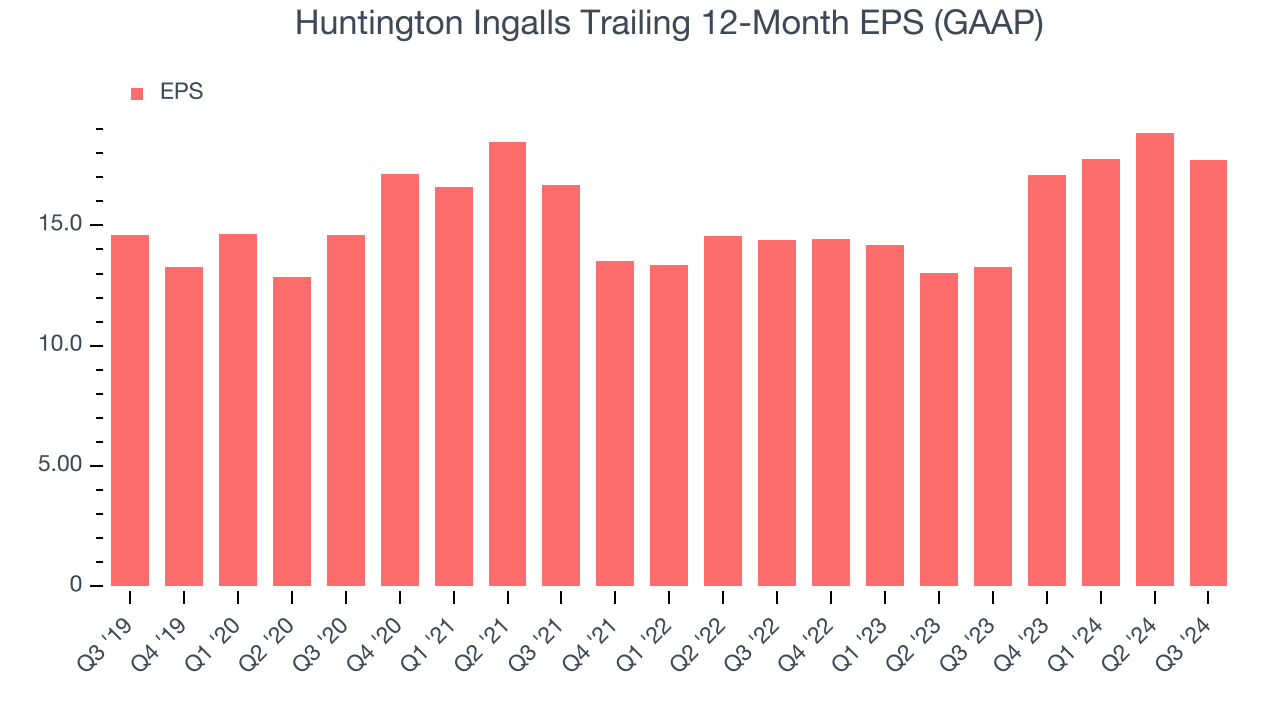
Diving into the nuances of Huntington Ingalls’s earnings can give us a better understanding of its performance. As we mentioned earlier, Huntington Ingalls’s operating margin declined by 1.2 percentage points over the last five years. This was the most relevant factor (aside from the revenue impact) behind its lower earnings; taxes and interest expenses can also affect EPS but don’t tell us as much about a company’s fundamentals.
Like with revenue, we analyze EPS over a more recent period because it can give insight into an emerging theme or development for the business.
For Huntington Ingalls, its two-year annual EPS growth of 11% was higher than its five-year trend. This acceleration made it one of the faster-growing industrials companies in recent history.In Q3, Huntington Ingalls reported EPS at $2.56, down from $3.70 in the same quarter last year. This print missed analysts’ estimates. Over the next 12 months, Wall Street expects Huntington Ingalls’s full-year EPS of $17.71 to stay about the same.
Key Takeaways from Huntington Ingalls’s Q3 Results
We struggled to find many strong positives in these results as its revenue and EPS missed Wall Street’s estimates. Overall, this was a weaker quarter. The stock traded down 10.7% to $224 immediately after reporting.
Huntington Ingalls may have had a tough quarter, but does that actually create an opportunity to invest right now? We think that the latest quarter is only one piece of the longer-term business quality puzzle. Quality, when combined with valuation, can help determine if the stock is a buy. We cover that in our actionable full research report which you can read here, it’s free.



